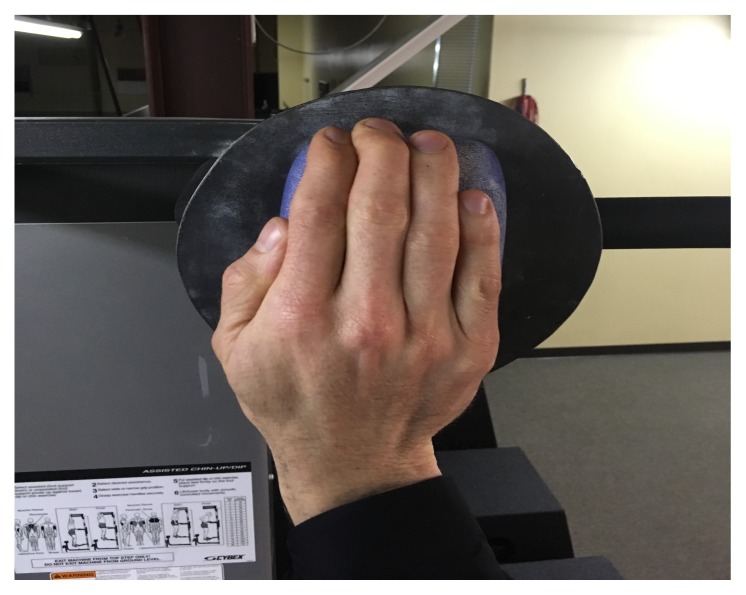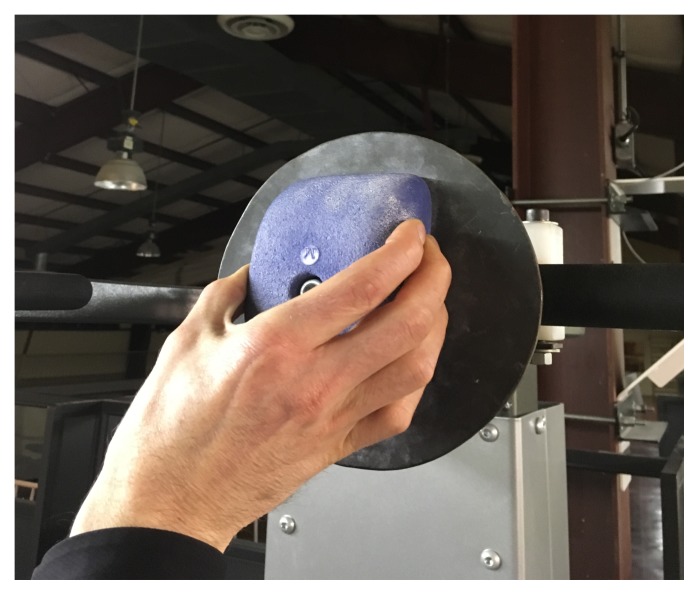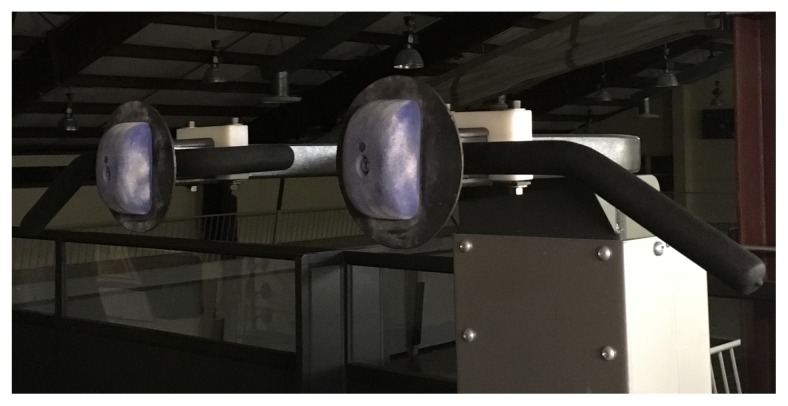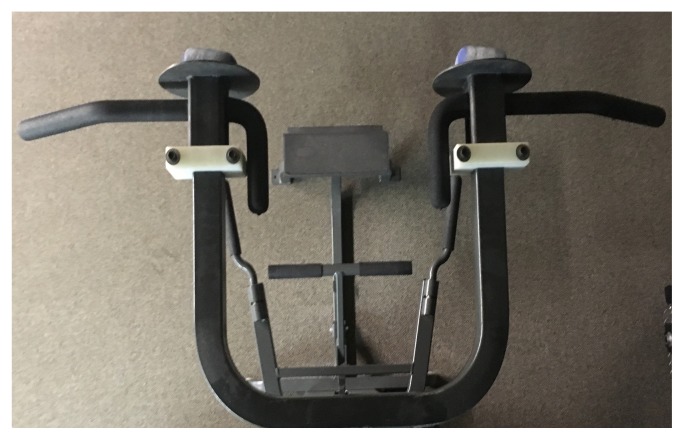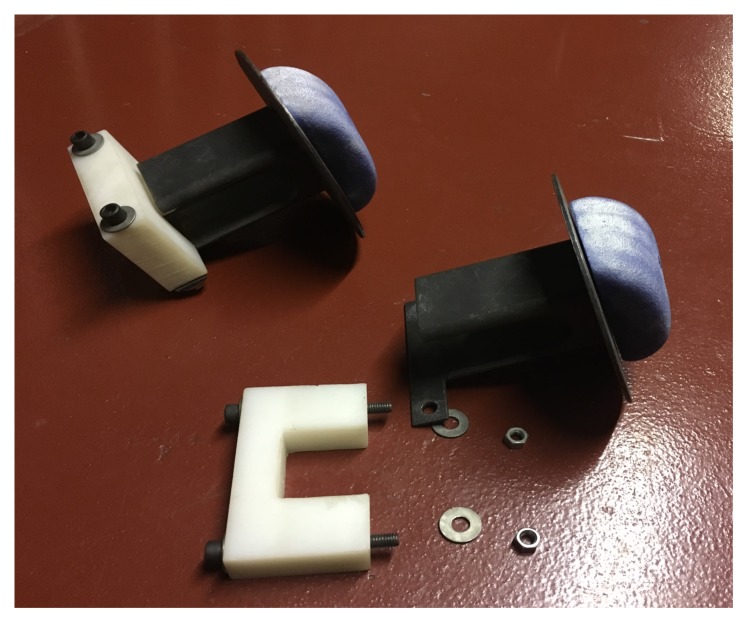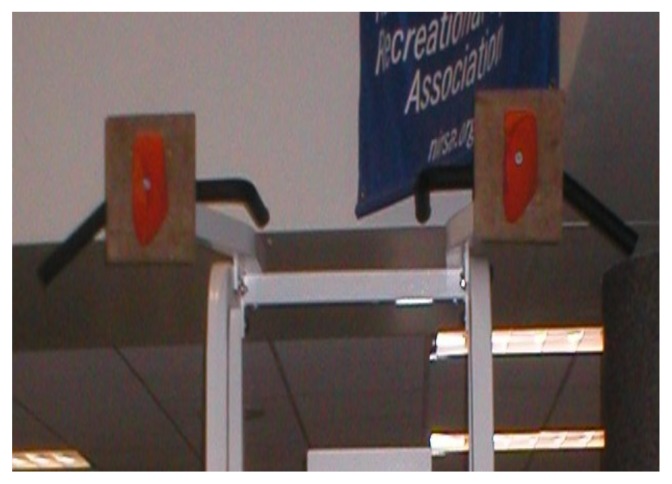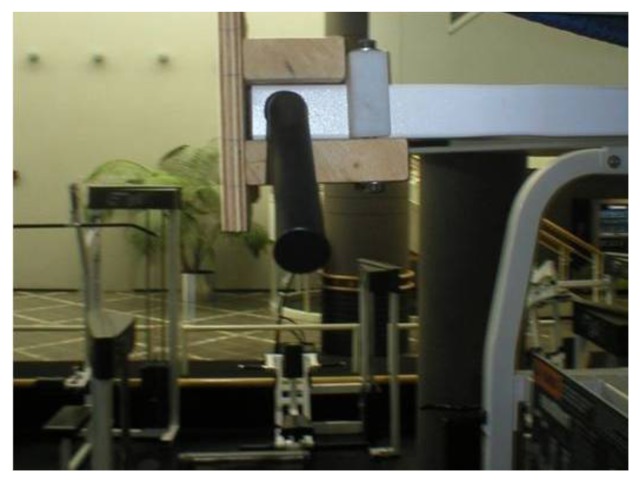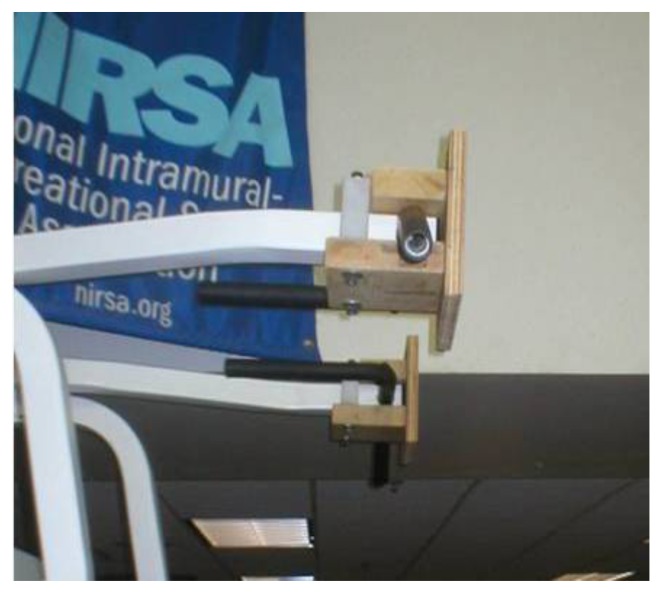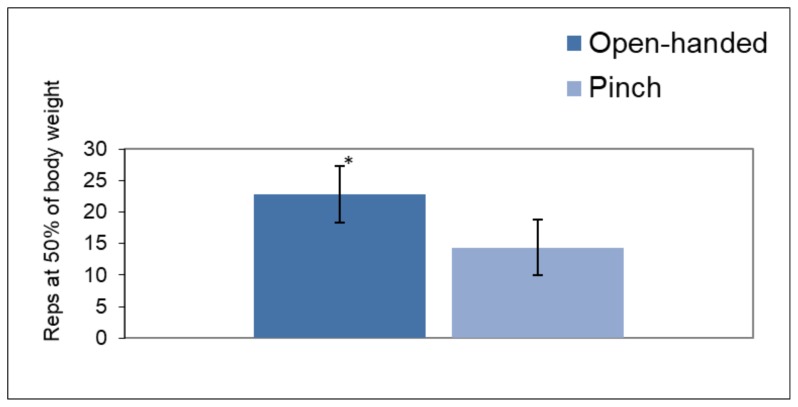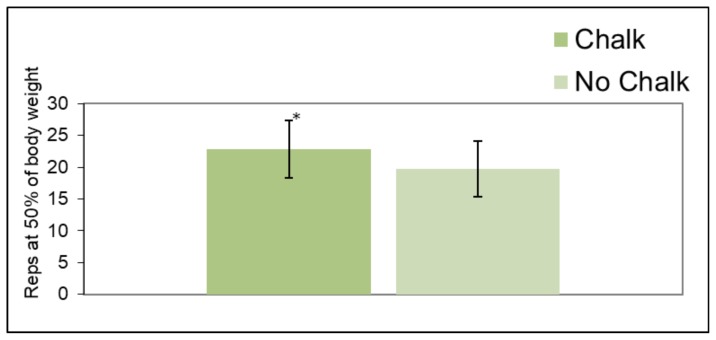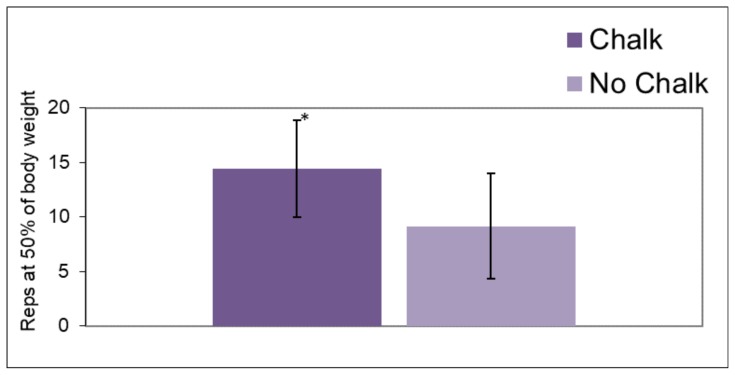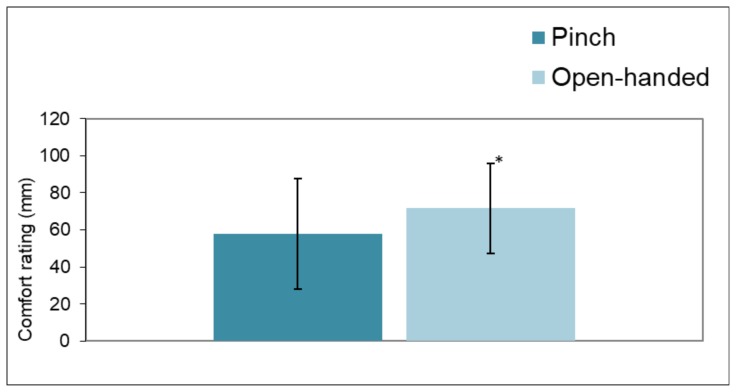Abstract
The purpose was to determine if pull-up performance was affected by the use of chalk (100% magnesium carbonate) during open-handed and pinch grip weight-assisted pull-ups (WAPU) in recreationally-trained rock climbers. Furthermore, the reliability of open-handed and pinch grip WAPU was also investigated. Recreationally-active volunteers (n = 9) completed six counterbalanced trials. Participants used chalk during four trials to determine the reliability (test-retest) of the open-handed and pinch grips. While two of the six trials were used to determine if open-handed and pinch grip WAPU performance was affected without using chalk. Three of the six trials included one set of open-handed WAPU, while the remaining trails included one set of pinch grip WAPU. Sets were performed until failure and consisted of either the open-handed or pinch grip pull-ups assisted by a 50% reduction of body weight. Heart rate, ratings of perceived exertion, perceived recovery scale and session-RPE were not significantly different (p > 0.05) among trials. Intraclass correlations (ICC’s) for test-retest of the open-handed (R = 0.99) and pinch grip (R = 0.96) WAPU evidenced reliable values. When compared to the non-chalked trials, chalk improved both openhanded (mean = 22.8 ± 4.53 vs. mean no chalk = 19.7 ± 4.39 reps; p = 0.006,) and pinch grip (mean = 14.4 ± 4.47 vs. mean no chalk = 9.1 ± 4.83 reps; p = 0.007) WAPU. ICC’s indicated a reliable measurement, while chalk improved performance for both open-handed and pinch grip WAPU when compared to no chalk trials.
Keywords: Bouldering, sloper, finger board, hang board, climb, training
INTRODUCTION
Limited research exists regarding an athlete’s chalk use and its relationship to sport performance (17). Observationally, athletes involved in rock climbing, gymnastics, Olympic weight lifting, and/or track & field (throws, pole-vault) often use chalk (7). Additionally, many rock climbers believe using chalk can improve their performance by minimizing their risk of falling off a route (17). Current research findings indicate chalk applied to the hands could potentially enhance the coefficient of friction between the climber’s hand and clean holds, diminish hand sweat and/or improve gripping performance through the chalk’s bonding agents (1, 12, 20). However of the aforementioned studies, only one study has investigated chalk’s direct relationship to climbing-specific, muscular endurance, performance testing (17).
In 2016, Kilgas et al. discovered an increase, of the climbers’ static hang time to failure, during the chalk trial compared to the non-chalked trial (17). Furthermore, during the static hang to failure, participants were required to use open-handed grips via a hang board. A hang board is a training device, made of polyester resin, and placed on indoor walls and/or above door frames allowing the user to perform a variety of pull-ups while using different grips. Two common climbing grips found on hang boards are open-handed and pinch grips (13). Open-handed grips are required when the climbing hold is angled downward (13, 17). The type of hold that an open-handed grip requires, is also known as a “sloper”. During the open-handed grip, the climber’s radioulnar joint is in a pronated position, radiocarpal joint is neutral, and the phalanges are slightly flexed around the hold (26). For clarification of a “sloper”, imagine sticking a bowl face-down on the wall and then cup your hand over it. Whereas, pinch grip holds place the radioulnar joint in a neutral position, radiocarpal joint is ulnar deviated, and relies on the phalanges and thumb to squeeze on opposite sides of the hold (13). For explanation of a “pinch”, visualize gluing the spine of a book on the wall, and simultaneously pinch the front and back covers. Both types of climbing-specific grips require adequate phalange, hand and forearm strength to keep from slipping off the hold (6). Additionally, Kilgas et al. reported that the use of chalk did not improve coefficient of friction, compared to non-chalked grip (17).
Li et al. also investigated chalk’s coefficient of friction, however used a variety of rock types: granite, slate and sandstone (20). The study utilized a custom-made device with strain gauges and compared a hand with and without chalk upon the three rock types and concluded that chalk reduced the coefficient of friction between the hand and all three types of rock. This suggests that chalk serves as a detriment to performance and the authors supported alternative means to dry the hands in order to improve climbing performance. Conversely, Fuss et al. demonstrated increased coefficients of friction with chalk use on sandstone and/or indoor climbing holds in dry conditions (13). This study utilized a miniature force plate with an indoor climbing hold (usually comprised of polyester resin, urethane, or a mix of both) in six diverse conditions: dry hand, wet hand, hand coated with crushed chalk, hand coated with liquid chalk, dry hand on a surface covered in liquid chalk, hand coated with crushed chalk on surface covered in liquid chalk. On a clean climbing hold, results indicated peak friction coefficients occurred during the use of crushed chalk when compared to liquid chalk, or a dry hand. The findings advocated a dry hand, instead of a chalk coated hand, when the climbing hold is unclean, or caked with chalk (13).
Additional studies have further supported the use of chalk in a climbing setting. Carré et al. investigated the use of liquid chalk, crushed chalk, and chalk-free hands on a sandstone plate attached to a similar device of the abovementioned studies. Findings indicated a higher friction coefficient during dry conditions of a hand coated in liquid or crushed chalk compared to a chalk-free hand (7).
With the exception of Kilgas et al., no studies have investigated chalk use and how it directly affects athletic performance (17). The primary purpose of this study was to evaluate the impact of chalk use on open-handed (Figure 1a) and pinch grip (Figure 1b) weight-assisted pull-up (WAPU) performance. A secondary purpose of the current study was to determine the test-retest reliability of both the open-handed and pinch grip WAPU in trained recreational rock climbers using a novel open-handed and pinch grip training device that interfaces with a WAPU machine (Figures 2a, 2b, 2c, and 2d). The prototype of the climbing-specific training device attached to the WAPU is also displayed in Figures 3a, 3b, and 3c. We hypothesized chalk use would increase the number of repetition of open-handed and pinch grip WAPU performed, and the custom-made training device would be reliable.
Figure 1a.
An open-handed grip being used on an indoor climbing hold. The climbing hold was attached to the training device, which was then assembled onto the WAPU.
Figure 1b.
A pinch grip being used on an indoor climbing hold. The climbing hold was attached to the training device, which was then assembled onto the WAPU.
Figure 2a.
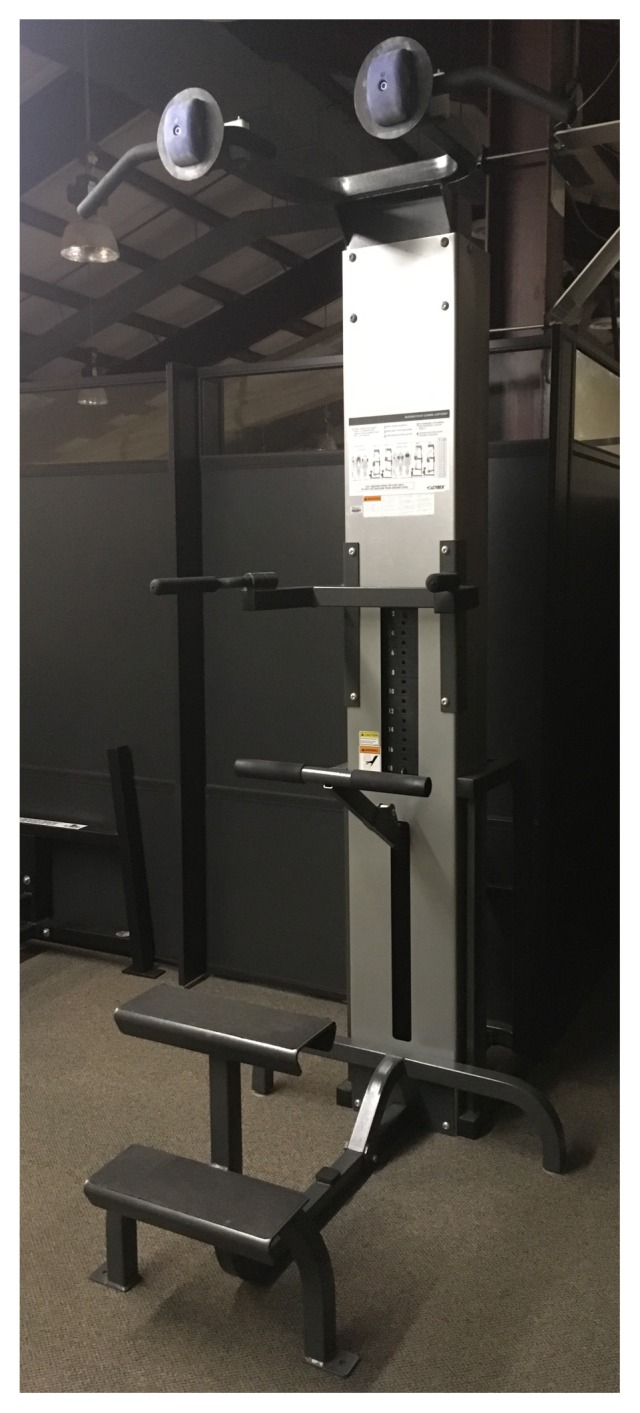
WAPU with the climbing hold training device attached.
Figure 2b.
Antero-lateral view of the climbing-specific training device.
Figure 2c.
The climbing hold apparatus attached to the WAPU machine via bird’s eye view.
Figure 2d.
The climbing hold apparatus disassembled from the WAPU machine.
Figure 3a.
Anterior view of the climbing-specific training device prototype, attached to the WAPU machine. The prototype was made of wood, and displays two orange, pinch grip climbing holds.
Figure 3b.
Lateral view of the climbing-specific training device prototype, attached to the WAPU machine. Shown without climbing holds attached. The plastic mechanism allowed the user to securely attach the apparatus to the WAPU via bolts, nuts and washers. This mechanism was also used on the final version of the device, which was made of metal (see Figure 2d).
Figure 3c.
Lateral, slightly inferior view of the prototype attached to the WAPU machine. Shown without climbing holds attached.
METHODS
Participants
Nine recreationally-active male climbers between the age of 19 and 28 years, participated in the study. Participants were recruited from a local, indoor rock-climbing facility. Study methods were approved by the University’s Institutional Review Board and all participants completed an informed consent, a health screening survey, and a Physical Activity Readiness Questionnaire (PAR-Q) prior to testing. Additionally, participants completed a training questionnaire that revealed they had completed a bouldering problem between V1 (Beginner) and V7 (Intermediate/Advanced) within the past twelve months. The V-Scale is used to quantify the difficulty level of a bouldering problem, and ranges from V0 (Beginner) to V15 (Open/Professional) (16). Anthropometric, training, and performance data of the participants’ can be seen in Table 1. Lastly, investigators asked participants not to alter their dietary habits, and to also restrict their engagement in vigorous climbing and other forms of upper-body exercise.
Table 1.
Mean + SD for anthropometric, training, and performance data of rock climbers (n = 9).
| Age (yrs) | 22.0 ± 3.0 |
| Height (m) | 1.8 ± 0.1 |
| Weight (kg) | 75.8 ± 8.0 |
| Body Fat (%) | 13.4 ± 5.6 |
| Months trained (months) | 22.0 ± 11.6 |
| Days trained per month (days) | 9.4 ± 5.3 |
| Hours trained per week (hrs) | 4.4 ± 3.5 |
| Dominant hand pinch strength (kg) | 6.8 ± 2.2 |
| Non-dominant hand pinch strength (kg) | 6.1 ± 1.8 |
Protocol
This study included a familiarization session and six counterbalanced WAPU experimental trials. The counterbalanced design of the experimental trials were based off of grip used (open-handed or pinch grip). Furthermore, three of the six trials used the open-handed grip (Figure 1a), while three trials used the pinch grip (Figure 1b).
In regards to chalk-use during the aforementioned experimental trials, four of the six trials (two open-handed trials and two pinch grip trials) were performed with block chalk (Metolius Climbing, Inc., Bend, OR), while two trials (one open-handed trial and one pinch grip trial) were performed without chalk. The four experimental chalked trials were used to evaluate test-retest reliability of open-handed and pinch grip WAPU, and this data were also used to compare to non-chalked experimental trials. The two, non-chalked experimental trials allowed investigators to evaluate the effect of chalk-use on open-handed and pinch grip WAPU performances. Each trial was separated by 72 hours, and each participant completed the study within three weeks of the familiarization trial. Additionally, the general use of a WAPU machine is to allow participants to perform pull-ups at a proportion of the participant’s body weight. A self-made device was affixed to the WAPU machine, and the device allowed participants to use the open-handed and pinch grip during WAPU (Figures 2a–d).
After successful completion of the informed consent and questionnaires, body height, weight, and percent body fat were evaluated. Weight and height were evaluated with a stadiometer which attached to the scale (Detecto, Webb City, MO). Participant’s percent body fat was predicted based on age and the sum of three skin-fold sites (chest, abdomen, and thigh) using skin-fold calipers (24). Subsequently, hand strength was measured from a hand dynamometer (Country Technology, Gays Mills, WI) which utilized the exact protocol found in a previous experiment (2).
After the aforementioned data were recorded, participants completed a familiarization session with the WAPU machine (Paramount Fitness Corp., Los Angeles, CA) and completed two sets of 10 repetitions of open-handed and pinch grip WAPU supported by 50% of body weight. The total weight supported by the WAPU machine was selected to the nearest 1.1 kg. Furthermore, the chosen percent body weight reduction was supported by previous published research (2). This body weight reduction decreased the intensity of the exercise, and thus allowed participants to perform multiple open-handed and pinch grip pull-ups. Without the assistance of the WAPU machine, many climbers would not be able to perform one open-handed or pinch grip pull-up.
A metronome was also used to standardize the speed in which the participants performed their WAPU. Participants were instructed to perform each pull-up completely in a controlled manner that would allow them to spend approximately the same time (~1.5 seconds) in the concentric and eccentric phases of motion. The tempo of the metronome corresponded with 20 pull-ups per minute, and verbal confirmation and count of each completed pull-up was also provided. The chosen tempo of 20 pull-ups per minute was supported by previous published research (2).
Following a period of at least 72 hours, participants reported back to the facility for one of six experimental trials. At the beginning of each experimental trial, participants’ resting heart rates (Polar USA, Ann Arbor, MI) and PRS (perceived recovery scale) scores were obtained. The purpose of the PRS is to quantify participants’ day-to-day recovery (18). Afterwards, participants were informed what grip and chalk condition they would be using to perform the WAPU. To begin the warm-up set, participants were instructed to place their hands on the climbing holds (~70 cm apart) and their knees on the machine’s support platform. The warm-up set consisted of 10 WAPU, using the informed grip and chalk condition, with 70% body weight assisted, and while including all the aforementioned parameters of the exercise. After competition of the warm-up set, a five-minute passive recovery was given to allow for acute recovery. After passive recovery was completed, participants then performed a single set of WAPU with 50% body weight assisted until failure. Termination of the test set revolved around one of three factors: the participant’s full range of motion was not met for two successive pull-ups, the participant could not maintain the 20 pull-ups per minute pace, or chose to quit. If one of three factors were met, then the investigators terminated the test set.
Immediately following failure of the test set, the final number of WAPU repetitions, HR, rating of perceived effort (RPE), and pinch-grip strength were recorded. Session RPE (S-RPE) was documented approximately 20 minutes post-test set as determined by Herman et al. (15). After S-RPE was documented, participants self-reported both overall grip comfort and joint strain using the custom-made apparatus on a 100-mm hedonic scale (4, 5). This type of scale has been used previously and was chosen to allow for parametric interpretation of data. (2, 8).
Statistical Analysis
To analyze the data, the Statistical Package for Social Sciences (SPSS, Inc., Chicago, IL) was utilized. Intraclass correlations (ICC) were run to determine the test-retest reliability between both trials of open-handed and pinch grip WAPU. In order to establish group mean differences between experimental trials of open-handed and pinch grip pull-ups (with and without chalk), repeated measures one-way ANOVAs were run for all variables of interest. Bonferroni post-hoc analyses were run on any significant omnibus result. For all statistical analyses, an alpha value was set at 0.05.
RESULTS
Table 1 displays descriptive characteristics of the participants. On average, the participants in this study had been climbing for approximately two years. Additionally, participants averaged 9 days of climbing-specific training, and self-reported approximately 4.5 hours of training per week.
ICC analysis revealed excellent test-retest reliability for both open-handed (R = 0.99) and pinch grip (R = 0.96) WAPU, correlations above 0.90 are considered acceptable (4, 5). Chalked-open-handed grip WAPU allowed the participants to perform more pull-ups when compared to the chalked-pinch grip, respectively (22.83 ± 4.53 repetitions, 14.39 ± 4.47 repetitions; p = 0.001) (Figure 3). Chalk increased both open-handed (p = 0.006) and pinch grip (p = 0.007) WAPU repetitions when compared to the non-chalked trials (Figures 4, 5). Figure 6 indicates overall comfort was significantly greater (p = 0.013) between chalked-open-handed (mean = 71.6 ± 24.16) vs. chalked-pinch grip (mean = 57.8 ± 29.78) WAPU. No differences were found for joint comfort and joint strain between grips, with or without chalk (p > 0.05). Furthermore no significant differences (p > 0.05) were found between –pre and –post pinch grip strength, RPE, HR, PRS, and S-RPE.
Figure 3.
Mean (± SD) open-handed and pinch grip weight-assisted pull-ups (sessions performed with chalk; *p < .05; n = 9).
Figure 4.
Mean (± SD) open-handed weight-assisted pull-ups with and without chalk (*p < .05; n = 9).
Figure 5.
Mean (± SD) pinch grip weight-assisted pull-ups with and without chalk (*p < .05; n = 9).
Figure 6.
Mean (± SD) 100-mm scale to measure perceived overall comfort of pinch grip and open-handed-grip weight-assisted pull-ups (sessions performed with chalk; *p < .05; n = 9).
DISCUSSION
The primary aims of this study were two-fold. To investigate whether chalk would improve open-handed and pinch grip WAPU performance, and examine the test-retest reliability for WAPU utilizing open-handed and pinch grips. Our study’s performance-based outcomes recommended magnesium carbonate be used during open-handed and pinch grip WAPU. Furthermore, the test-retest reliability of the open-handed and pinch grip WAPU, using trained recreational rock climbers, was reliable.
The principal results of the current study suggested chalk increased both open-handed (p = 0.006) and pinch grip (p = 0.007) WAPU repetitions when compared to the non-chalked trials (Figures 4, 5). In the present study, chalk improved performance for both open-handed and pinch grip WAPU and supports Kilgas et al., the first study published investigating chalk-use and performance (17). Kilgas et al. utilized recreational-climbers and investigated their hang time to failure using a hang board. Participants used an open-handed grip, and were instructed to hang statically for as long as possible. Their results indicated that static hang time improved using chalk (62.95 ± 36.75 seconds), when compared to the non-chalked trial (49.30 ± 25.18 seconds; p = 0.046) (17). Both studies support the use of chalk as it relates to climbing-specific, performance-based, movements.
The secondary purpose of our study was to determine the reliability of the custom-made apparatus. Currently there are no prior research publications investigating reliability of open-handed or pinch grips WAPU. However, test-retest ICC’s of the open-handed and pinch grips (R 0.99 and 0.96, respectively), suggest a highly reliable instrument. Additionally, closed-handed WAPU and the modified pull-up created by Pate et al. (1987) have been evaluated and found to be reliable (3, 9, 19, 21, 22, 25).
Most of the published research articles investigating chalk-use took a different approach. These studies investigated chalk’s coefficient of friction on various surfaces. Though the current investigators did not evaluate chalk’s coefficient of friction, these previous findings motivated the creation of the current study, and thus should be briefly mentioned.
Li et al. results indicated that chalk reduced the friction coefficient between the climber’s hand and rock (slate, sandstone, and granite) (20). Furthermore the investigators concluded chalk-use on the hands had no physical benefit to rock climbers, and its utility may only have been of psychological benefit. Conversely, Fuss et al. and Carré et al. results indicated peak friction coefficients occurred during the use of crushed chalk when compared to liquid chalk, in a dry environment (7, 13). The aforementioned studies investigated the friction coefficients generated from a pronated hand laying on a surface, as the surface pulled away from the hand. In each of the studies, investigators utilize a different apparatus to examine the friction coefficients. The conflict in results may have to do with differences in the engineered apparatus determining the friction coefficient between the surface and hand. Lastly, these apparatuses were not climbing-specific.
Unlike the aforementioned studies, the approach of Kilgas et al. to investigating chalk’s coefficient of friction was directly related to a climbing-specific task (17). During this study, investigators assessed chalk’s coefficient of friction while participants were statically hanging from a hang board. Participants hanged until failure, and the investigators calculated the coefficient of friction using force plates attached to the hang board. Their coefficient of friction results indicated no differences between chalked and no-chalked trials.
Our study also indicated that participants performed fewer pinch grip WAPU when compared to open-handed WAPU (Figure 3). Additionally, investigators discovered participants reported that the pinch grip was more uncomfortable (Figure 6) compared to the open-handed grip when using the WAPU machine. Unfortunately biomechanical research related to the sport of climbing is limited, and perhaps has to do with the inherent nature of the sport. As rock climbing involves an extreme complexity of movement patterning, encompassing most joints, while in all planes of motion (sagittal, lateral, transverse, and diagonal).
Climbers often use an assortment of hand holds, varying in size and shape. Hand holds include slopers (open-hand), pinches (pinch grips), edges (crimps), jugs, pockets (one, two and/or three finger), and cracks (11). Moreover, the climbing hold orientation is also of equal importance, and limits how the climbing hold can be used (11). Because of the vast variety of climbing holds and their fixed orientation on the wall/rock, there are a plethora of movement options to ascend a route. However under the conditions of our study, we only investigated open-handed and pinch grip WAPU as the radioulnar joints were pronated, and the radiocarpal joints were extended with (pinch grip) or without (open-handed) ulnar deviation. Although our study did not investigate the line of pull of joints and connective tissue, we did investigate WAPU using two climbing-specific grips, and thus are in support of mentioning the biomechanical analyses of the pull-up movement pattern. Furthermore, during rare conditions (i.e. an indoor climbing route), a climbing hold orientation may allow the climber to use a supinated grip when ascending route, therefore the chin-up is also discussed below.
Piscopo found that the mechanical aspects of performing a pull-up were dependent upon two lines of pull, direct and twisting. The study indicated that during elbow flexion of a supinated radioulnar joint, the mechanical advantage becomes maximized when the direct line of pull from the biceps brachii is created (23). Furthermore, Gabbard et al. found that a chin-up (supinated radioulnar joint) allowed the participant to do more chin-ups when compared to performing a pull-up (pronated radioulnar joint) (14). Piscopo supported similar findings and concluded that during elbow flexion and radioulnar supination, the direct line of pull from the bicep tendon to the bicep allowed the participants to perform more chin-ups (23). Under the conditions of our study, the investigators required the participants to perform open-handed WAPU while the radioulnar joints were pronated and the radiocarpal joints held in an extended position (Figure 1a). Figure 1b displays the pinch grip. The pinch-grip WAPU required the participant to undergo extension of the radiocarpal joint as well, however with ulnar deviation. Therefore under the conditions of our study, the participants were at a disadvantage from the beginning of their pinch grip WAPU. This disadvantage was due to the orientation of the climbing hold, which required a fixed, lateral positioning of the radiocarpal joint (ulnar deviation) to maintain contact with the pinch-shaped hold.
Lastly, we observed no difference between pre- and post- trial for pinch grip strength. We attributed this to the rock climbers having an increased ability to recover from ‘sustained and rhythmic isometric exercise’ due to improved vasodilatory capacity of the forearm and hand (10). Because of climbers’ enhanced vasodilatory capacity, perhaps they had sufficient recovery between pre- and post- pinch grip strength sessions, and therefore no difference was detected.
Chalk improved open-handed and pinch grip WAPU performance. The new device utilized during this study, could aid individuals who are attempting to improve hand-grip strength and endurance while performing a compound movement (pull-ups, flexed/extended arm hangs, etc.) within the weight room, rather than using the standard closed-handed grip. This climbing-specific device attached to the WAPU machine, could allow for a structured, sport-specific, training program for rock climbers. Although many climbers would not be able to use all of their body weight when performing pull-ups requiring a variety of grips, this device could allow for these climbing-specific pull-ups to be performed. As the users’ WAPU performance improves, they could simply lessen the assistance of the WAPU machine and/or increase the difficulty of the climbing grips. In general, utilizing the open-handed grip would enable trainers and coaches to satisfy the basic principles of training and potentially provide more ecological validity for sport climbers, who rarely perform tasks with a close-handed grip. Additionally, climbers training to improve their open-handed and pinch grips, should continue to use chalk when training and/or competing. The long popularity of chalk use among climbers provides some testimony to its utility.
In summary, we recommend that chalk be used to increase performance under these conditions. Furthermore, the performance measurement was reliable. Future research should investigate climbing performance using different types of dry and liquid chalk, on various indoor climbing holds and rock types.
ACKNOWLEDGEMENTS
Our appreciation is extended to Drs. John Clark, Ann Godfrey and Charlie Katica as well as Shawn Gendle, Stephen Buckner, Nathan Fedor and Tyler Boswell for their assistance throughout the study.
REFERENCES
- 1.Amca AF, Vigouroux L, Aritan S, Berton E. The effect of chalk on the finger-hold friction coefficient in rock climbing. Sports Biomech. 2012;11:473–79. doi: 10.1080/14763141.2012.724700. [DOI] [PubMed] [Google Scholar]
- 2.Bacon NT, Wingo JE, Richardson MT, Ryan GA, Pangallo TC, Bishop PA. Effect of two recovery methods on repeated closed-handed and open-handed weight-assisted pull-ups. J Strength Cond Res. 2012;26:1348–52. doi: 10.1519/JSC.0b013e318231a610. [DOI] [PubMed] [Google Scholar]
- 3.Baumgartner T, Gaunt S. Construct related validity for the Baumgartner Modified pull-up test. Meas Phys Educ Exerc Sci. 2005;9:51–60. [Google Scholar]
- 4.Baumgartner T, Jackson A, Mahar M, Rowe D. Measurement and evaluation in kinesiology. Burlington, MA: Jones & Bartlett Learning Publisher; 2015. [Google Scholar]
- 5.Bishop P. Measurement and evaluation in physical activity applications. Scottsdale, AZ: Holocomb Hathway Publisher; 2008. [Google Scholar]
- 6.Burbach M. Gym climbing: maximizing your indoor experience. Seattle, Wa: The Mountaineers Books; 2004. [Google Scholar]
- 7.Carré MJ, Tomlinson SE, Collins JW, Lewis R. An assessment of the performance of grip enhancing agents used in sports applications. Proc Inst Mech Eng J J Eng Tribol. 2012;7:626–25. [Google Scholar]
- 8.Casey JC, Herron RL, Bishop SH, Ryan GA, Bishop PA. Validity of a visual analog scale for assessing RPE. Med Sci Sports Exerc. 2015;47:787. [Google Scholar]
- 9.Engelman M, Morrow J. Reliability and skinfold correlates for traditional and modified pull-ups in children grades 3–5. Res Q Exerc Sport. 1991;62:88–91. doi: 10.1080/02701367.1991.10607523. [DOI] [PubMed] [Google Scholar]
- 10.Ferguson RA, Brown MD. Arterial blood pressure and forearm vascular conductance responses to sustained and rhythmic isometric exercise and arterial occlusion in trained rock climbers and untrained sedentary subjects. Eur J Appl Physiol Occup Physiol. 1997;76:174–80. doi: 10.1007/s004210050231. [DOI] [PubMed] [Google Scholar]
- 11.Flanagan D. Bouldering essentials. Poland: Three Rocks Publisher; 2013. [Google Scholar]
- 12.Fuss FK, Niegel G. The importance of friction between hand and hold in rock climbing. Sports Tech. 2012;5:90–9. [Google Scholar]
- 13.Fuss FK, Niegl G, Tan AM. Friction between hand and different surfaces under different conditions and its implication for sport climbing. Eng Sport. 2004;5:269–75. [Google Scholar]
- 14.Gabbard C, Patterson P, Elledge J. Grip and forearm position effects on tests of static and dynamic upper body endurance. Res Q Exerc Sport. 1981;52:174–79. doi: 10.1080/02701367.1981.10607855. [DOI] [PubMed] [Google Scholar]
- 15.Herman L, Foster C, Maher M, Mikat R, Porcari J. Validity and reliability of the session RPE method for monitoring exercise training intensity. South Afr Sports Med. 2006;18:14. [Google Scholar]
- 16.Josephsen G, Shinneman S, Tamayo-Sarver T, Josephsen K, Boulware D, Hunt M, Pham H. Injuries in Bouldering: A prospective study. Wild Envir Med. 2007;18:271–80. doi: 10.1580/06-WEME-OR-071R1.1. [DOI] [PubMed] [Google Scholar]
- 17.Kilgas MA, Drum SN, Jensen RL, Phillips KC, Watts PB. The effect of magnesium carbonate (chalk) on geometric entropy, force, and electromyography during rock climbing. J Appl Biomech. 2016;32:553–557. doi: 10.1123/jab.2016-0009. [DOI] [PubMed] [Google Scholar]
- 18.Laurent CM, Bishop PA, Green JM, Richardson MT, Sjokvist J, Schumacker RE, Curtner-Smith M, Thomas W. Effect of gender on fatigue and recovery during and following repeated maximal intensity sprint exercise. J Sports Med Phys Fitness. 2010;3:243–53. [PubMed] [Google Scholar]
- 19.Levinger I, Goodman C, Hare D, Jerums G, Toia D, Selig S. The reliability of the 1RM strength test for untrained middle-aged individuals. J Sci Med Sport. 2009;12:310–316. doi: 10.1016/j.jsams.2007.10.007. [DOI] [PubMed] [Google Scholar]
- 20.Li FX, Margetts S, Fowler I. Use of ‘chalk’ in rock climbing: sine qua non or myth? J Sports Sci. 2001;19:427–32. doi: 10.1080/026404101300149375. [DOI] [PubMed] [Google Scholar]
- 21.Pate R, Ross J, Baumgartner T, Sparks R. The modified pull-up test. JOPERD. 1987:71–73. [Google Scholar]
- 22.Pate R, Burgess M, Woods J, Ross J, Baumgartner T. Validity of field tests of the upper-body muscular strength. Res Q Exerc Sport. 1993;64:17–24. doi: 10.1080/02701367.1993.10608774. [DOI] [PubMed] [Google Scholar]
- 23.Piscopo J. Assessment of forearm positions upon upper arm and shoulder girdle strength performance. Kin IV. 1974:53–7. [Google Scholar]
- 24.Pollock ML, Schmidt DH, Jackson AS. Measurement of cardiorespiratory fitness and body composition in the clinical setting. Compr Ther. 1980;6:12–27. [PubMed] [Google Scholar]
- 25.Romain B, Mahar M. Norm-referenced and criterion-referenced reliability of the push-up and modified pull-up. Meas Phys Educ Exerc Sci. 2001;5:67–80. [Google Scholar]
- 26.Vigouroux L, Quaine F, Labarre-Vila A, Moutet F. Estimation of finger muscle tendon tensions and pullet forces during specific sport-climbing grip techniques. J Biomech. 2006;39:2583–92. doi: 10.1016/j.jbiomech.2005.08.027. [DOI] [PubMed] [Google Scholar]



